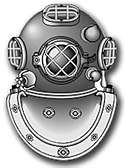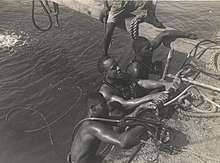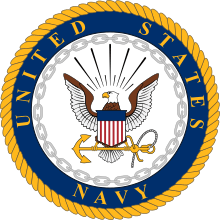Navy diver (United States Navy)
A United States Navy diver refers to a member of the community of restricted line (Engineering Duty) officers, civil engineer corps (CEC) officers, Medical Corps officers, and enlisted Navy diver (ND rating) personnel in the United States Navy who are qualified in underwater diving and salvage. Navy divers serve with fleet diving detachments and in research and development. Some of the mission areas of the Navy diver include marine salvage, harbor clearance, underwater ship husbandry and repair, submarine rescue, saturation diving, experimental diving, underwater construction and welding, as well as serving as diving technical experts at Navy SEALs, Marine Corps, and Navy EOD diving commands.
| Navy Diver | |
|---|---|
 U.S. Navy enlisted rating insignia | |
| Issued by | United States Navy |
| Type | Enlisted rating |
| Abbreviation | ND |

The U.S. Navy is the lead agency in military diving technology and training within the U.S. Department of Defense. The foundation of the Navy diving program consists of the Navy Diver (ND) rating for enlisted personnel who perform diving as their occupational specialty in the Navy.[1]
History
"The early history of diving in the U.S. Navy parallels that of the other navies of the world. Since the middle of the nineteenth century, the U.S. Navy has employed divers in salvage and repair of ships, in construction work, and in military operations.
For the most part, early Navy divers were swimmers and skin divers, with techniques and missions unchanged since the days of Alexander the Great. During the Civil War Battle of Mobile Bay, swimmers were sent in ahead of Admiral Farragut's ships to locate and disarm Confederate mines that had been planted to block the entrance to the bay."[2]
In 1898, Navy divers were briefly involved in an international crisis when the second-class armored battleship USS Maine (ACR-1) was sunk by a mysterious explosion while anchored in the harbor at Havana, Cuba. Navy divers were sent from Key West to study and report on the wreck. Although a Court of Inquiry was convened, the reason for the sinking was not found.
The beginning of the twentieth century saw the attention of all major navies turning towards developing a weapon of immense potential - the military submarine. The highly effective use of the new weapon by the German Navy in World War I heightened this interest, and an emphasis was placed on the submarine that continues today.
The U.S. Navy had operated submarines on a limited basis for several years prior to 1900. As American technology expanded, the U.S. submarine fleet grew rapidly. However, throughout the period of 1912-1939, the development of the Navy's F, H, and S class boats was marred by a series of accidents, collisions, and sinkings. Several of these submarine disasters resulted in a correspondingly rapid growth in the Navy diving capability.
Until 1912, U.S. Navy divers rarely went below 60 FSW (feet of seawater). In that year, Chief Gunner George D. Stillson set up a program to test Haldane's diving tables and methods of stage decompression. A companion goal of the program was to develop improvements in Navy diving equipment. Throughout a three-year period, first diving in tanks ashore and then in open water in Long Island Sound from the USS Walke (DD-34), Navy divers went progressively deeper.
The publication of the first U.S. Navy Diving Manual and the establishment of a Navy Diving School at Newport, Rhode Island were the direct outgrowth of experience gained in the test program and the USS F-4 salvage. When the United States entered World War I, the staff and graduates of the school were sent to Europe, where they conducted various salvage operations along the French coast.[3]
WWII brought with it an expanded need for divers that began immediately at Pearl Harbor. There the focus was on salvage. The creation of Naval Construction Battalions to build advance bases in the Pacific put more diving assignments in front of the Navy. Enough that the Seabees had a divers school of their own to qualify 2nd class divers. CBs would put men in the water from the tropics to the Arctic circle. In the Aleutians CB 4 had divers doing salvage on the Russian freighter SS Turksib in 42°F water..[4] Seabees would also blur the definition of diver with the development of the Underwater Demolition Teams. Another historic note to the Seabees is that they had African American divers in the 34th CB. Those men fabricated their diving gear in the field. Twice, while at Milne Bay, the 105th CB sent special diving details on undisclosed missions. The war itself produced an unending demand for underwater ship repair. Each of the fleets repair ships had divers and the six off the USS Vestal were put to test using the new technology of underwater cutting and welding. The stern was nearly completely blown off the USS Pensacola. They removed three propellers and stabilized ship structure enough so that she could be towed to a drydock. During WWII, "diver" was a qualification not a rate.
In 2006, the U.S. Navy established the rating, Navy Diver (ND). Marine salvage remains a primary task of Navy divers, but they also maybe involved in special operations.
Training and ratings
The Schools
After completion of recruit training or acceptance in the Navy diver program from the Fleet, individuals will go to Naval Training Command, Great Lakes, for Diver Preparation Course (32 training days, including 20 days of basic electrical and engineering courses). Upon completion of the training, candidates will go to Naval Diving and Salvage Training Center (NDSTC) in Panama City, Florida, for Second Class Dive School, which is 70 training days long.
The center has 22 different courses of instruction and a throughput of approximately 1300 students per year, with an average of 300 students in training at any given time. The training center conducts approximately ten thousand dives each year.
The NDSTC is divided into Fleet and specialized sections. Regardless of their section, all candidates are taught:
- Basic gas laws as they relate to diving.
- Diving medicine
- Decompression chamber operations
- Dive planning
- Diving physics
- Salvage operations
- Surface-supplied diving systems
- Use of all diving apparatus: Open- and closed-circuit rigs
- Underwater mechanics and tools, and underwater cutting and welding
Fleet Training
After completing Second Class Dive School, the member will be assigned to one of the Navy Diver Units to hone the undersea diving and salvage skills required by the United States Navy. A Navy diver can perform underwater ship repair, salvage, and construction, using either SCUBA equipment or a surface-supplied diving system. Training for Diving Medical Officers and diving medical technicians is also part of Fleet training.
Advanced Training
Many experienced divers return to NDSTC for further course work so they can qualify as First Class divers and Master divers. The first-class dive school is approximately 12 weeks long. During training, students are subjected to several training drills and tests. Some of the subjects include Hyperbaric Chamber, SCUBA, MK-16 Rebreather, Surface Supplied Air, and Mixed Gas Supervisor. Students are taught how to diagnose diving-related illnesses as well as handling system emergencies. While attending First Class Dive School, students partake in Master Diver Evaluations. During Master Diver evaluations, candidates are put through a number of challenging scenarios. Only a select few candidates ever achieve the title of Master Diver. Becoming a Master Diver is one of the highest titles that a Navy Diver can achieve.[5]
Specialized Training
A Navy diver gets specialized training in demolition and mixed-gas diving.[6]
Navy divers work in extreme conditions, performing various underwater tasks ranging from underwater ship repair, underwater salvage and special operations/special warfare type diving. Because their area of operations are so varied, they can be required to utilize any type of diving equipment for use in any depth or temperature in any part of the world. Certain diving qualification allows NDs to live and work at extreme depths for days or weeks at a time, a discipline known as saturation diving.
Navy enlisted personnel that graduate from second class or first class dive school; and ultimately master diver comprise the Navy Diver rating. NDs are the in-water operators and supervisors for the various mission areas mentioned previously as their primary day to day mission is that of in-water operator and/or supervisor. There are three enlisted diving badges/qualifications in the ND rating:
- Second class diver - E-4 to E-5 personnel. This is the basic diving qualification in the ND rating, awarded upon completion of ND 'A' School (pin awarded upon warfare qualification). Primary duties are to serve as in-water operators during various missions.
- First class diver - E-6 to E-8 personnel. Advanced diving qualification awarded upon completion of ND 'C' School. In addition to duties as a second class diver, first class divers serve as diving and chamber treatment supervisors.
- Master diver - The highest enlisted diving position in the Navy. Awarded upon successful completion of the master diver course which includes exceptionally demanding diving operational problems and acceptance by a master diver board. Oversees diving operations and train/qualify diving supervisors.
Personnel in the CEC (Seabee) ratings can qualify as underwater construction technician (UCT). Like other Navy divers, UCTs are primary in-water operators that conduct underwater construction. They also have three qualification levels with similarities to those in the navy diver rating.
Navy hospital corpsmen can qualify as a diving medical technician (DMT), where they are given training in medical aspects of diving. Primary responsibilities are to provide medical advice and treatment to diving personnel. They also instruct members of the diving team in first aid procedures when the presence of diving medical personnel is indicated.
Additionally, there is a scuba diver qualification primarily for those stationed on submarines to serve as sub divers in a limited capacity. Navy scuba divers are also trained at NDSTC at a 5-week course. Their duties consist primarily of conducting occasional inspections on the submarine they are stationed on. Scuba divers maintain their traditional Navy rating such as ET or MM; their diving Navy Enlisted Classification (NEC) is a collateral duty, not their primary one.
U.S. navy diver physical fitness test
Diving medical personnel evaluate the fitness of divers before operations begin and are prepared to handle any emergencies which might arise. They also observe the condition of other support personnel and are alert for signs of fatigue, overexposure, and heat exhaustion. The physical fitness test has been shown to be a poor predictor of job task performance.[7]
The test consists of the following carried out in the order given:[8]
- Swim 500 yards (or 450 m) utilizing only combat side stroke or breast stroke within 12 minutes 30 seconds (candidates are allowed to push off the sides when turning. However, if the candidate uses the bottom to stand or rest, they will fail the test).
- 10-minute rest period.
- Perform 50 push-ups within 2 minutes (Upper arms must parallel deck at dip and arms locked out at the top of the rep).
- 2-minute rest period.
- Perform 50 curl-ups within 2 minutes (Bent knees. Candidates hands must stay on the collarbone and the elbows must touch the knees).
- 2-minute rest period.
- Perform 6 pull-ups within 2 minutes (no kipping or swinging is allowed and the chin must clear the top of the bar on each repetition).
- 10-minute rest period.
- Run 1.5 miles (2.414 km) within 12 minutes 30 seconds.
Note: The times and quantities listed are for passing the screening test only. Each candidate's scores are submitted and the candidates with the top scores along with ASVAB exam scores will be selected and given a navy diver contract. Passing the physical fitness test is necessary but by no means guarantees the candidate a contract.
Health impact
A study published in 2011 by the Navy Experimental Diving Unit reviewed the long term health impact on the U.S. Navy diving population.[9] The divers surveyed participated as divers for an average of 18 years out of their average 24 active duty years.[9] Sixty percent of the divers surveyed were receiving disability compensation.[9] One in seven of the divers had experienced neurologic symptoms of decompression sickness, with 41% of the divers experiencing one or more of the nine diving injuries surveyed.[9] Seven percent of the surveyed divers had undergone a joint replacement.[9] Eighty-six percent of the divers rated their health as "Excellent, Very Good, or Good".[9] When compared to the general population, the divers showed better mental health but poorer physical health.[9]
Ratings
The navy diver rating was announced in Naval Administration Message 003/06 and consists of sailors with the following NECs:
The effective date of the ND rating was June 1, 2006 for E6-E9 sailors (petty officer 1st class and above), and October 1, 2006 for E1-E5 sailors.
Enlisted rating designators

- E4 (ND3) — Navy diver third class
- E5 (ND2) — Navy diver second class
- E6 (ND1) — Navy diver first class
- E7 (NDC) — Chief Navy diver
- E8 (NDCS) — Senior Chief Navy diver
- E9 (NDCM) — Master Chief Navy diver
Officer designators
MILPERSMAN 1210-140 Designation as a Diving Officer for selected (1) Unrestricted Line (117X, 112X), (2) Restricted Line/Staff Corps (146X, 144X, 210X, 510X), (3) Limited Duty (61XX, 648X, 653X), and (4) Warrant (71XX, 72XX, 748X, 753X)
1440 — Engineering Duty (restricted line) Officer
510x — Civil Engineer Corps (staff) Officer
720x — Diving (warrant) Officer
 Underwater welding
Underwater welding_2_and_Naval_Special_Warfare_Logistics_Support_conducting_Lock_Out.jpg) SEAL delivery operations
SEAL delivery operations Salvage Operations
Salvage Operations Submarine rescue
Submarine rescue Harbor clearance
Harbor clearance Navy diver swimming
Navy diver swimming SCUBA
SCUBA Closed circuit
Closed circuit
See also
- Uniform Service Diver Insignia (United States) – Qualification badges of the uniformed services of the United States which are awarded to servicemen qualified as divers
- Military diving – Underwater diving in a military context by members of an armed force
- Master diver (United States Navy) – Senior diver rating in US Navy
- Carl Brashear – One of the first African Americans to become a U.S. Navy Master Diver
- United States military divers – Underwater divers employed by the US armed forces, including navy, army, marines, air force and coast guard
References
- "Navy Expeditionary Combat Command - Diving". www.public.navy.mil. Retrieved 2016-09-25.
- Navy Diver: A Tradition of Honor!,by Salty Dog Old School,Feb 7, 2020, Crows Nest website, NavyCrow.com
- "Navy Expeditionary Combat Command - Diver History". www.public.navy.mil. Retrieved 2016-09-25.
- Water Temperature Table of the Alaska Coast, National Centers for Environmental Information, last updated: Sat Jun 06, 23:02:52 UTC 2020
- (PDF) https://www.public.navy.mil/bupers-npc/reference/milpersman/1000/1200Classification/Documents/1220-100.pdf. Missing or empty
|title=(help) - "Diver Training". www.public.navy.mil. Retrieved 2016-09-25.
- Marcinik, EJ; Hyde, DE; Taylor, WF (1994). "Development of job-related physical selection criteria for U.S. Navy fleet divers". Undersea and Hyperbaric Medicine. 21. Retrieved 2013-11-21.
- Staff (6 Jan 2013). "SEAL/EOD/SWCC/DIVER/AIRR Physical Screening Testing Standards and Procedures" (PDF). MILPERSMAN 1220 - 410. BUPERS - 324 ). pp. 1–10. Retrieved 6 April 2017.
- Chung, J; Brugger, J; Curley, M; Wallick, M; Perkins, R; Regis, D; Latson, G (2011). "Health survey of U.S. Navy divers from 1960 to 1990: A first look". US Navy Experimental Diving Unit Technical Report 2011-11. Retrieved 2013-11-21.
- NAVPERSCOM (PERS - 401D H ) ND "A" School Coordinator (30 May 2013). "Navy Diver ( ND ) Rating" (PDF). MILPERSMAN 1220 - 100. BUPERS - 32 4F Enlisted Community Manager. p. 3. Retrieved 6 April 2017.
Sources
- Supervisor of Diving, Naval Sea Systems Command, 2007. US Navy Diving Manual .(UK): AquaPress Publishing. ISBN 1-905492-06-5. Revision 5. Hardback. The complete manual for equipment, procedures and operations established by the Department of Navy.
- Supervisor of Diving, Naval Sea Systems Command, 2007. US Navy Diving Manual .(UK): AquaPress Publishing. ISBN 1-905492-00-6. Revision 5. Looseleaf. The complete manual for equipment, procedures and operations established by the Department of Navy.
- https://web.archive.org/web/20080310094417/http://www.necc.navy.mil/diver/
- https://web.archive.org/web/20090712084127/http://www.necc.navy.mil/content.htm
External links
| Wikimedia Commons has media related to United States Navy Divers. |
